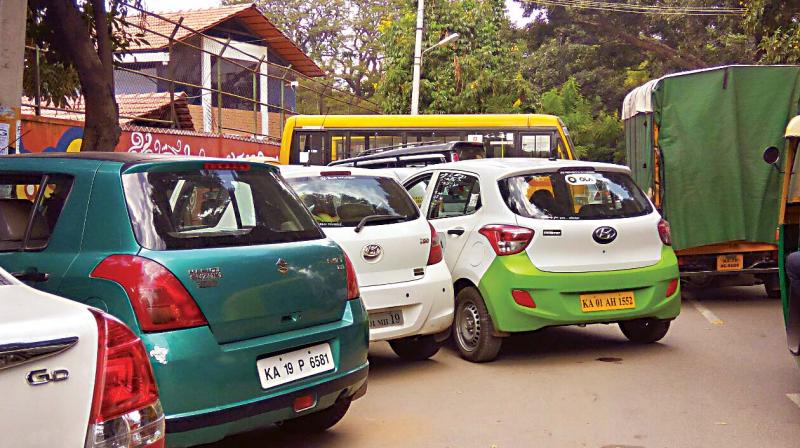Our roads paved with parking woes

Home to some 65 lakh private vehicles, Bengaluru's traffic snarls are well known across the country. Haphazard parking, with cabs and other private vehicles stopping at random on busy roads before attempting to merge with incoming traffic has magnified the congestion. Cabs waiting for passengers and drivers awaiting their owners by the kerb are a common sight in Bengaluru, despite the fact that parking in unregulated zones could result in penalties or one's car being towed. Solutions are staring us in the face: No Stopping Zones on main roads, CCTVs at major junctions, autorickshaws kiosks and parking bays and laybys for buses, taxis and citizens. It’s time for a revamp, says Nikhil Gangadhar.
The city has grown in leaps and bounds and vehicular traffic has grown with it at an alarming pace – the city is home to some 65 lakh privately owned automobiles. This has resulted in, apart from congestion on the roads, chaos in the existing, albeit meagre parking facility provided across Bengaluru. With few rules to govern them, cabs and private vehicles park abruptly on busy stretches, obstructing the flow of traffic, which only worsens the snarls.
Haphazard parking and the continuous merging of vehicles from side lanes is one of the major problems witnessed in the city. 100 Feet Road in Indiranagar, Brigade Road, Gandhi Nagar, Seshadripuram, Old Madras Road, M.G. Road, JP Nagar, Jayanagar, Majestic and K.R. Market are some of the problem areas.
Read | Guest Column: Time to look at tech-driven solutions
Rishab Pandey, whose office is on Brigade road says it takes him about 20 minutes to get through the stretch, thanks to cars parked obtrusively on the side of the road. “Brigade Road isn’t more than 250 metres in length but it takes a commuter over 20 minutes to get from one end to the other. People park abruptly with little thought to vehicles behind them. Cab drivers are the prime culprits and the police should enforce stern rules.” Cab drivers usually pull up on the side of the road to await passengers, often on busy stretches. This is the case with private vehicles too, they park their cars on these roads and ask their drivers to wait until they finish running their errands.
Additional Commissioner of Police (Traffic) R. Hithendra says regulations exist but more stringency will be applied. “We have been strict about enforcing parking laws and often tow vehicles parked in restricted zones or on pavements.
However, when drivers park their vehicles on the side of the road or by the curb, they don’t seem to realise that they’re hindering traffic flow. We have asked traffic police personnel to ensure that nobody stops on the road. We will discuss the problem further to come up with solutions to help curb the menace.
Another senior traffic police officer, who did not want to be identified, said, “Certain traffic experts had advised us to make sure that the vehicles do not stop on busy stretches, apart from BMTC buses, vehicles carrying senior citizens and physically challenged people. This is an apt solution which can be tested and implemented, if is effective. We can direct cabs and other private vehicles to park their vehicles on parallel roads of the busy stretches and walk to their destination. The same applies to people who want to hail autorickshaws. We are also setting up autorickshaw kiosks which will dissuade them from parking anywhere they want. ”
‘No Stopping’ signs on busy roads the way forward, says IISc prof
Dr Ashish Verma, associate professor at the Department of Civil Engineering, IISc, Benglauru, says No Stopping signs are a must on busy stretches. “Officials concerned should ensure that this happens, for it will help curb the menace. Strict enforcement of the law and harsh penalties for offenders will help bring down random halts on the side of the road.”
Dr Verma adds that several countries have implemented the ‘No Stopping’ zones, to great success. “Cabs and private vehicles are often seen stopped on the roads which tend to eat into the carriage way and this results in traffic jams, as vehicles coming from behind have to navigate and the flow of traffic is stopped. When they’re ready to move, these vehicles attempt to merge with flowing traffic, adding to the congestion. It’s all about road discipline, which is the responsibility of the motorist. Unfortunately, there is none here.”
Authorities are well-equipped in terms of technology, he adds, which will help police enforce the law. “Offenders should be penalised heavily. And there’s no need for police personnel to be present to monitor the situation, they can install CCTVs and monitor the footage to catch offenders,” he says.
Moreover, authorities simply can’t provide parking space in every area and street. “If we provide space on a busy stretch, we’re inviting more vehicles and causing more jams. The only solution is No Stopping zones.”

